 полная версия
полная версияPacking and Portaging
The following is another method of slinging packs, frequently used by forest rangers:
Throw the rope across the horse directly in front of the saddle, and as in the previous method form two half hitches with the rope at its middle on the front fork, but in this case permitting the ends to lie on the ground on either side the horse. Place the near pack in position and against the lower rope, and holding it with one hand, bring the rope up and over the pack with the other hand and throw a half hitch around the forward fork, keeping the free end of the rope under. Draw the rope taut, lifting the pack well up. Pass the running rope back and throw a half hitch around the rear fork, the loose or running end of the rope on the under side, as when forming the half hitch on the front fork. Now pass the running rope from under over the pack at the rear, throw a half hitch over the rear fork, take up all slack, bring the loose end under and around the two ropes at their intersection between pack and rear fork, and tie securely. The pack on off side is slung in similar manner.
Most mules, and not infrequently horses as well, have a constitutional dislike to receiving the pack. If your pack animal displays any such tendency adjust the blind over his eyes and let it remain there until the hitch is thrown and the load tightened and secured. The blind is usually an effective quieter.
CHAPTER XI
SOME PRACTICAL HITCHES
WHETHER the load is made up with kyacks, alforjas, or separate packs slung to the crosstree saddle as described in the preceding chapter it must be secured in place. For this purpose various hitches are employed by packers, each hitch well adapted to the particular conditions which evolved it.
Our description will be confined to the following six hitches, which furnish ample variety to suit the exigencies of ordinary circumstances:
(1) The crosstree or squaw hitch, which is the father of all hitches because from it the diamond, the double diamond and all pack-train hitches in present-day use were evolved.
(2) A diamond hitch, adapted to the crosstree pack saddle. This is a form of single diamond.
(3) The United States army diamond particularly adapted for use with the aparejo. The true double diamond is a hitch rarely called for save in army work or freighting pack trains, and will therefore be omitted. There are several so-called double diamonds that might be described, but these near-double diamonds possess little or no advantage over the single diamond, and we shall pass them over as they are scarcely resorted to in ordinary pack work.
(4) The one-man or lifting hitch.
(5) The stirrup hitch, to be used when the packer has rope but no cinch.
(6) The saddle hitch, employed in slinging loads upon an ordinary riding saddle.
(7) The hitch for packing a sick or injured man.
THE CROSSTREE HITCH
This hitch was introduced into the Northwest by the early fur traders and adopted by the Indians. Among Indians, women are the laborers, and the crosstree hitch being the hitch almost exclusively employed by the squaws was presently dubbed by white men the "squaw hitch." It is a hitch very generally used by prospectors, and for this reason is known in some localities as the "prospector's hitch." In other sections of the West, where sheep herders commonly use it, it is locally called the "sheep herder's hitch." It is a hitch easily thrown by one man, holds well, and is therefore a favorite.

Squaw or Crosstree Hitch
(Fig. 1.) Rope engaged on cinch hook and bight of rope running from rear forward under standing rope.
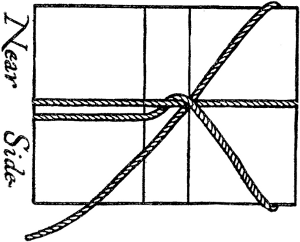
(Fig. 2.) Loop of bight enlarged, reversed and passed around bottom and lower corners of off side pack.
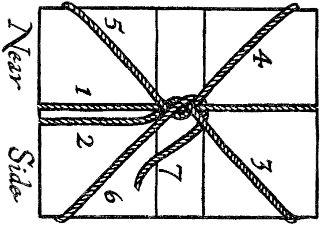
(Fig. 3.) Hitch formed and ready to tighten. 1. Standing rope. 2. Running rope. 3. Rear rope—off side. 4. Front rope—off side. 5. Front rope—near side. 6. Rear rope—near side. 7. Marker.
With lash rope attached to cinch, take a position on the near side of the animal facing the pack. Throw the cinch over the top and center of pack in such manner as to be easily reached under the horse's belly. Pick up cinch and engage the rope from in out upon the hook. Draw up slack, taking care that the cinch rests properly upon the horse's belly. Grasp the running and standing rope in left hand above the hook, to hold slack, and with the right hand double the running rope and thrust the doubled portion under the standing rope from rear forward in a bight, at top of pack. Enlarge the loop of the bight by drawing through enough slack rope to make the loop of sufficient size to be passed over and around the off side kyack or pack. Step to off side, turn loop over, and engage it around the ends and bottom of kyack, from front to rear. Return to near side, and pass the loose end of running rope around the forward end, bottom and finally rear end of kyack. Draw the rope end, from above down, over and under the standing rear and running ropes, at the top and center of the load, and the hitch is ready to tighten.
To tighten the hitch, grasp the running rope a little above the cinch hook, and pull with all your strength, taking up every inch of slack possible. Retain this slack by holding the standing and running rope together with left hand, while with the right hand you reach to top of load and pull up slack where running rope passes under standing rope. Go to off side and draw in all slack, following the rope around off side pack. Retaining slack, return to near side, and still following rope and taking up slack around front to rear of near side pack, grasp end of rope, already engaged as directed over and under standing rear and running rope, pull hard, bracing a foot against pack, and tie. Two men, one on each side of the horse, can, of course, throw the hitch and tighten the load much more quickly than one. Tightening the load is just as important a feature of packing as evenly balancing the packs. The result of an improperly tightened load will pretty certainly be a sore-backed horse.
THE CROSSTREE DIAMOND HITCH
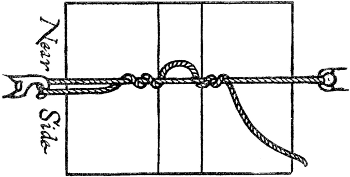
(Fig. 1.) A turn is here taken around standing rope with loop of bight of running rope thrust under standing rope from rear to front, as in Fig. 1, illustrating Squaw Hitch.
Take position on the near side of horse, as when forming the crosstree hitch, and throw cinch over horse, engaging it on hook and adjusting it in exactly similar manner. Take in slack and retain it by grasping the standing and running ropes in left hand. Double running rope and thrust doubled portion under standing rope in a bight, from rear forward at top and center of load. Take up all slack. Enlarge loop of bight by drawing through enough running rope to form a diamond of sufficient size to hold top of load. Now bring center of loop over and under standing rope, from rear forward, thus giving rope at each side of loop a complete turn around standing rope. Throw the disengaged portion of running rope to off side of horse, and passing to the off side, bringing the rope down along rear, bottom, and up front of kyack, thrust loose rope end up through loop at top of pack. Take in slack and return to near side of horse. Engage running rope around front, bottom and rear end of near side kyack or pack, and thrust rope end over and under standing rope opposite center of loop. Take up slack and load in ready to tighten.
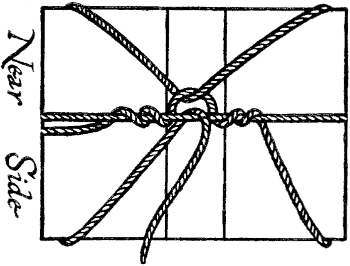
Crosstree Diamond Hitch
(Fig. 2.) Hitch formed ready to tighten.
Tighten load by grasping running rope above hook and drawing as tight as possible. Hold slack with left hand, gripping running and standing rope, and take up slack at loop with right hand. Pass to off side and take up slack and tighten rear to front around kyack. Pass to near side, tightening front to rear; finally, bracing a foot against the load pull on loose end, and retaining all slack make final tie.
The above described "diamond" hitch is not the true diamond employed by government pack trains where the aparejo is used, but it is a diamond evolved from the crosstree hitch, and is particularly well adapted to the crosstree or sawbuck pack saddle, is easily formed, and holds the load securely, which is the ultimate object of all hitches.
THE UNITED STATES ARMY DIAMOND HITCH
The single diamond hitch employed by army packers is the ideal hitch for securing a load upon an aparejo. This is a two-man hitch, though an expert can throw it alone.
One packer takes his position on the off side of the animal, while the other with the coiled lash rope, cinch attached, remains on the near side.
The near packer, retaining the cinch, throws the coiled rope over the horse's haunch, to rear. The off packer picks up end of rope, and receiving the hook end of cinch, passed to him under horse's belly by near packer, holds it
together with end of rope in his left hand, and stands erect.
United States Army Diamond Hitch
Figures represent successive stages in formation. Near side towards right in each case. Line PP in Fig. 1 represents horse's back. AA (Fig. 3) standing part of rope, and A´ (Fig. 2) the running rope.
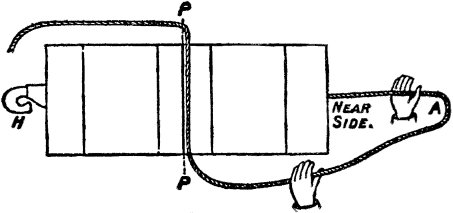
Fig. 1.
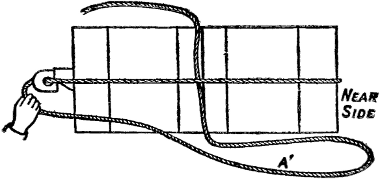
Fig. 2.
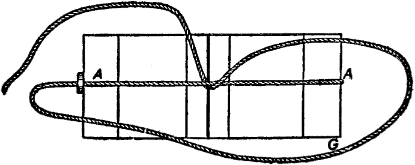
Fig. 3.
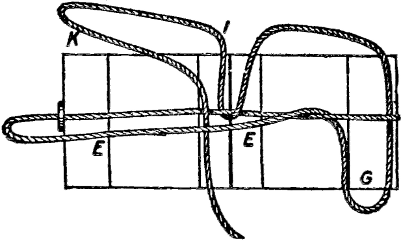
Fig. 4.
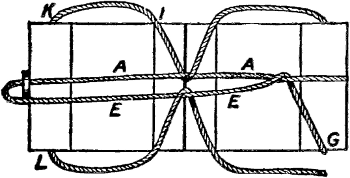
Fig. 5.
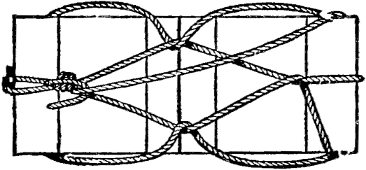
Fig. 6.
The near packer, taking a position at the horse's neck, grasps the rope about six feet from cinch, and with an upward and backward motion, drops it between the two packs, one slung on either side of the aparejo.
Still grasping the rope in his right hand just forward of the packs at the top, he pulls forward between the packs sufficient running rope to permit him to bring his hand down to his side. Retaining the rope in his right hand he now reaches up with his left hand, and with back of hand up and thumb under grasps running rope and draws sufficient rope forward to permit the left hand grasping the rope to come down to his side, arm's length.
With the right elbow crooked the right hand, still holding the rope, is brought up about on a level with the chin, and the left hand, also retaining its hold on the rope, thumb down, is raised to hollow of the right arm, with loop of rope between the hands lying outside the right arm. Now by a single swinging motion with both hands the rope in the right hand, called the "standing rope," is thrown over the center of pack to the off packer who stands ready to receive it; and the rope held in the left hand, called the "running rope," over the horse's neck, forward of the pack.
The off packer, still standing with cinch hook and end of rope in left hand, with his right hand grasps the standing rope as it comes over as high up as he can conveniently reach, draws it down, and holding the cinch hook in proper position below the aparejo draws down the standing rope and engages it upon the hook from in out.
The near packer now draws forward between the packs about six feet more rope, which he throws to the rear of the near side pack. This rope is now called the "rear" rope. He next grasps the running rope at the horse's neck, and with the off packer's assistance releases that portion of the running rope lying between the packs forward of the standing rope, and brings it to the center of pack on near side, next to and just back of the standing rope.
He now slips his right hand down the rope to a point half way between pack and aparejo boot, and with the left hand reaches from forward between standing rope and aparejo and grasps the rope just above the right hand. Both hands are now slipped down the rope, and with the same motion drawn apart, one on each side of standing rope (under which the rope being manipulated passes) to the cinches. With the hands about ten inches apart, the section of rope between them, which is held in a horizontal position, is jammed down between the two cinches under the aparejo.
The off packer, holding the running rope with his right hand above the hook, places the left hand holding end of rope on top of running rope between his right hand and the hook, and with thumb under running rope grasps both ropes and slips his hands up on running rope, bringing it to center of load.
He now draws the end of the rope, held by left hand, forward until a foot or so falls upon the near side of the horse's neck. The hitch is now formed, ready to tighten.
To tighten, the near packer with his left palm passing the side and center of the pack grasps the running rope at the rear of the standing rope, at the same time bringing the running rope between the thumb and index finger of the left hand, which he is using as a brace. In this position he is prepared to hold slack as it is given him by the off packer.
The off packer grasps the running rope close down to the hook, and, bracing himself with a knee against the aparejo boot, pulls with all his might, taking two or more pulls, if necessary, and giving slack to near packer, until no more slack can be taken on standing rope. He now steps smartly to rear and throws the top rope forward of the pack. The top rope is the rope leading up from the rear corner of the aparejo boot on near side to the side and center of off side pack. After it is thrown forward it is called the "front" rope. He now prepares to receive slack from near packer by grasping the rear rope where it lies between the packs.
The near packer, who has been receiving the slack given him by the off packer, carries his right hand, with which he holds the slack at rear of standing rope, to lower side of pack toward the aparejo, and reaches under standing rope, with left hand grasps rope above right hand, drawing it forward under standing rope, and employing both hands jams it upward in a bight between standing rope and pack. Care should be taken during this operation to retain all slack.
The near packer now engages around front boot of aparejo the free portion of the running rope below the bight just formed. Holding slack with left hand, he grasps the rope to rear of cinch in right hand; receiving slack from left hand he brings rope to rear of aparejo boot, and with both hands carries rope smartly to upper corner of side pack, always retaining slack. The off packer receives slack, pulling it in quickly hand over hand, the near packer retaining his hold until the off packer has the rope taut. The near packer now takes a position at the forward end of load, facing the rear, and grasps end of rope prepared to take slack from off packer.
The off packer, after receiving slack from near packer as described takes a turn of the rope around each hand, holding every inch of slack, steps to the rear, keeping in line with the horse's body, and then facing forward throws his full weight back upon the rope. Retaining the slack with his left hand, with his right hand he brings the free portion of running rope under and around the aparejo boot, from rear to front, passes forward of rope, and facing the rear and grasping rope, right hand above the left, brings it smartly to upper corner of pack.
The near packer, holding end of rope, immediately draws in slack until he has about six feet of free rope, which he throws over center of load to off side, and then drawing in all remaining slack takes a turn of rope around each hand and throws his weight upon it, and the off packer releases his hold.
Holding the slack with the left hand, the near packer releases his right hand and with it engages the free or running portion of rope under and around the aparejo boot to rear of load, while the off packer steps to rear of load, takes end of rope, and while he draws in all slack, neatly coils rope, holding coil in right hand at lower side of pack, and, with palm of left hand braced against center of load, receives slack from near packer.
Grasping in his left hand the taut rope above the coils, and lifting it sufficiently above the load to admit the coiled rope under it, he swings the coils with his right hand from rear to front to top of load and brings the standing rope held in his left hand down on top of the coils to hold them. He now takes a loop of the rope, forces it between standing rope and pack, in a bight, and takes a turn of the loop around standing and running rope to secure it, first joining the loop well up, and the hitch is tightened.
THE ONE-MAN OR LIFTING HITCH
This is a pretty good hitch sometimes where kyacks are not used and an irregular pack is swung upon the crosstree. While it holds the pack very securely to the animal's back, its tendency is to lift the corners that might cause friction upon the horse's sides.
Standing on the near side of the horse, throw cinch over the horse's back, pick up cinch and engage rope upon cinch hook, from in out, as in previous hitches. Take up slack, bring running rope up side of pack, double and thrust loop or bight under standing rope from rear forward at top of pack, to hold slack. Throw all loose rope to off side, and pass around to off side yourself.
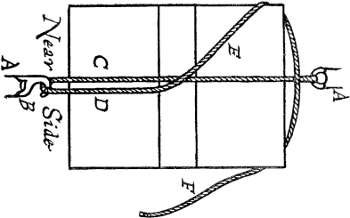
(Fig. 1.)
A—Cinch
C—Standing rope
B—Cinch hook
D—Running rope
E—Front rope
F—Marker
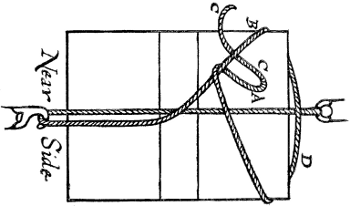
Lifting Hitch
(Fig. 2.) Grasp loop A in left hand and with right jam rope C C along and under rope B (where latter passes beneath corner of pack) to D, as shown in Fig. 3.
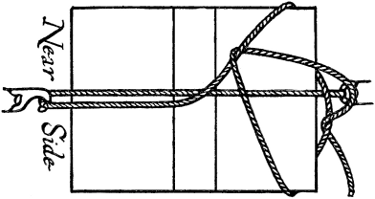
(Fig. 3.) Off side of hitch completed.
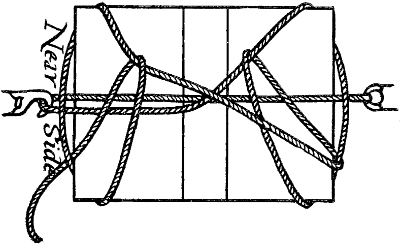
Lifting Hitch
(Fig. 4.) Hitch formed ready to tighten.
Draw loose end of running rope forward and from under standing rope at top of pack. The effect of operations thus far is this: The running rope passes up the near side, from hook and to top of load and passes under standing rope, which will serve effectually in final tightening of cinch to hold slack.
Pass end of running rope over and under the forward end of off pack and backward under standing rope and pack. Now bring the rope forward over side of pack, double, and thrust the doubled portion over and under forward rope in a bight. With left hand grasp double of rope at bight just to rear of forward rope where it passes over and under forward rope, and with right hand slip running rope down and just to rear of standing rope. Take up slack. By pulling hard upon loose end of running rope the ends of pack will be lifted slightly.
Throw loose end over horse to near side, and across middle of load. Pass to near side and manipulate rope as on off side. Tighten load. Secure the hitch by bringing loose end of rope over and under forward running and standing ropes, and tie.
STIRRUP HITCH
This hitch is useful where the packer has lash rope but no cinch, and may be employed on sawbuck saddle, aparejo, or where the load is hung upon an ordinary riding saddle. It is a two-man hitch, though one man may manipulate it.
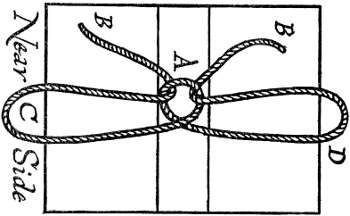
(Fig. 1.) Rope is thrown across load with equal portion falling on each side. Loop A is formed on top of load, and the ends BB are passed through it to form large loops C and D.
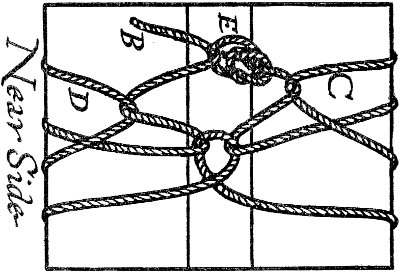
Stirrup Hitch
(Fig. 2.) Loops C and D are passed under horse's belly and seized by packers on opposite sides. Each packer then draws end of rope which he is holding through loop which has been passed to him. Off packer forms bowline knot, E, and near packer passes his end of rope through this. Hitch is now ready to tighten.
Pass the rope over the load, with an equal
division of rope on either side. Form a loop at center and top of load. Each packer will now place a foot upon the rope, where it falls from loop to ground, and pass his end of rope through loop from above down and draw through slack rope. This forms a loop on either side in which the foot rests. Each packer will now bring forward and under the horse's belly the loop in which his foot rests, passing the loop to the other packer at the same time disengaging his foot, and will pass the loose end of rope which he holds through the loop which he receives. The ropes on top of pack will now be spread to properly cover and secure the pack, and all slack taken.
The off side packer now forms a bowline knot in the loose end of his rope, the near side packer passes his loose end through the bowline loop. To tighten the load the off side packer gives slack, while the near side packer braces and draws in on loose end of rope, tying at bowline loop to secure load.
THE SADDLE HITCH
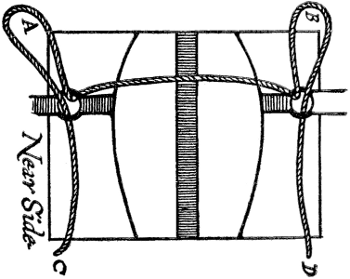
Saddle Hitch
With rope arranged as shown throw deer across saddle, enlarge loops A and B around haunches and neck. Bring ends C and D together, form bowline knot on end D, pass end C through it and tighten.
This is a particularly useful hitch when it becomes necessary to sling a deer to a riding saddle for transportation to camp.
Throw the lash rope across the saddle seat, an equal division of rope falling to either side. Double the rope where it crosses the cinch ring and thrust it through the cinch ring in a loop, drawing through enough loose rope to form a good-sized loop. This should be done on both sides. Lay the deer across saddle, with head hanging on one side and haunches on the other side, slip loop on one side over the deer's head, and the loop on the other side over its haunches. Take in all slack. Form a bowline loop on end of off side rope, and lay it on top of load. This loop should be so adjusted as to reach the middle of the top of load. Passing to near side, thread loose end of near side rope through the bowline loop. Tighten load by pulling on loose end, and tie.
HOW TO PACK A SICK OR INJURED MAN
Sometimes it occurs that a member of a party is so injured or becomes so ill as to be helpless, and the problem of transporting him upon horseback presents itself. This may be done in the following manner upon a crosstree or sawbuck saddle:
Cut two straight sticks three feet long and about three inches in diameter. Fit one on either side of saddle snug against the forks. Lash securely to forks forward and rear, with ends of sticks protruding an equal distance forward of and back of forward and rear forks. It may be well to cut shallow notches in the sticks where they rest against the forks. This will preclude lateral motion.
Cut two sticks two feet long and three inches in diameter. Place one in front and one in rear at right angles to and across top of sticks already in position. These cross-pieces are to be lashed to position one about two inches from forward ends, the other two inches from rear ends of lengthwise sticks. Before lashing them into position cut notches to receive lash ropes at points of intersection, that any tendency to slip or work loose may be overcome.




